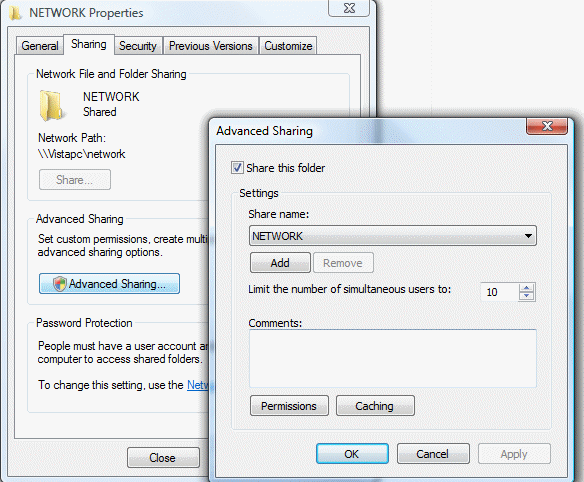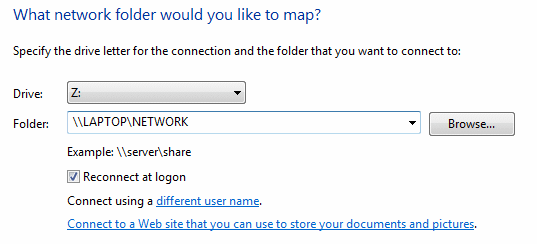
This page is about the sharing of files with a mapped network drive, to make the files available by other computers attached in the network. First a warning: be careful which files and folders you share, don't share your whole C: partition or your My Documents folder! I have seen badly secured wireless networks with all files shared. Consequences: all your personal information are easy found (passwords, e-mail, personal files, Live Messenger chats, visited websites, favorites, possibly your income (tax papers),.....)! I prefer to create a folder the name NETWORK on the D: partition and share this folder also with the name NETWORK.
Sharing the folder is done by right clicking the folder and select Sharing and Security. Confirm you understand the security risks but don't use the wizard. Now you see that you are able to share this folder on the network. Enable the sharing option and the share name will NETWORK will be filled in (enable the option Allow network users to change my files as well, if you would like that others are allowed to change your shared files). The folder icon will change, a hand will be added.
In Windows Vista, sharing files is not that different. Right click the partition or folder (in this case D:\NETWORK) and select Share, Everybody (all users in this list) in the combo box and click the button Add. The next step is to change the permission level to Contributor (or even Co-owner) which gives the user who access the files have the permission to change the shared files. The button Share will eventually show the exact network share to access the shared folder (in this case \\VISTAPC\NETWORK). The link Show me all the network shares on this computer shows all the previously shared folders. After clicking the button Done the folder icon will be changed to make it recognizable as a shared folder.
The set permissions and the name of the shared folder can be edited by right clicking it, Properties, tab Sharing, button Advanced settings. To use the advanced settings by default, disable the sharing wizard (go to Organize, Folder and Search Options, tab View and disable Use Sharing Wizard (recommended)). A folder can be shared with multiple names, but this does not make it more clearly. After adding a new network name, the permissions have to be set as well.

|
|
The Network and Sharing Center (Windows Vista)
Windows Vista has multiple security levels for sharing files, which can be
changed in the
Network
and Sharing Center
(available in the Control Panel). At least, the option File sharing has
to be turned on, if necessary supplemented with the option Password protected
sharing
(without this option activated, a password is asked for as well, but in those
cases a random name can be used). It is also possible to activate the option
Public folder sharing to share files, but using the public folder has the
disadvantage that the files to share must be placed in this folder.
In the Network and Sharing Center, the sharing of files, printers and media files is activated separately. To make the sharing work, it is necessary that the option File and Printer Sharing for Microsoft Networks (available by clicking View status in the Network and Sharing Center, button Properties) has been enabled. Remember that a firewall can block the requests for accessing shared files as well.
First you have to make sure all computer in your network are operating in the same workgroup. This is done by Control Panel, System, tab Computername, button Change. Use a short and simple name for the workgroup (default is MSHOME or WORKGROUP) and use a short and simple computer name for all computers in your network.
To view the shared files on the other computer, you can browse your network. This is done by starting the Windows Explorer and navigate to Desktop, My Network locations (if needed, right click and select Explore), Full network, Microsoft Windows network. Here you will see the name of your network (default is MSHOME or WORKGROUP). Double clicking this icon will show all available computers in your network.
If you are not able to see the other computers in your network, make sure you are not blocked by the firewall (don't forget to switch of the Windows firewall if you are using firewall software!). Check if the other computer has shared files (else there is nothing to find) and that File and printer sharing for Microsoft networks hasn't been switched of (see the internet connection settings above)! For Windows Vista, the sharing of files must have been enabled in the Network and Sharing Center.
HOW TO KNOW WHICH FOLDERS ARE SHAREDIf you would like to have an overview of the shared folders on your computer, use a Windows build-in tool. Start, Run and enter the following command: Rundll32.exe ntlanui.dll,ShareManage. Of course, you can also create a shortcut. |
HIDING SHARED FOLDERS FROM THE NETWORKTo make sure the shared folder isn't visible by exploring the network-neighborhood, you can add a dollar-sign ($) at the end of the share name (in this case NETWORK$ instead of NETWORK). The share can only be accessed by creating a network connection with the exact same share-name (see below). |
SEARCHING COMPUTERS FASTER IN YOUR NETWORKIt can take some time to find another computer on your network. First, your
computer searches for a WINS-server, where all connected computers are registered.
First you have to wait until your computer comes to the conclusion that there is
no WINS-server. Then you have to wait for the next step: at 'randomly'
broadcasting packages until a computer is found. To skip the search for a
WINS-server, you have to do a
registry tweak. Add (or change) the DWORD-value NodeType=1 to the
following registry key: |
HIDE YOUR COMPUTER FROM THE NETWORKIf you would like to hide your PC from other computers in the network, you can achieve this with the command NET CONFIG SERVER /HIDDEN:YES in the command prompt (Start, Run and enter the command CMD). By changing YES to NO you can make your computer visible again. The current status can be determined with the command NET CONFIG SERVER. |
This is a very time consuming and irritating way of opening a shared folder (sometimes you will never see the shared files and folders!). However, I prefer to create a network connection which always works quickly (if there is no firewall blocking the access). The network connection will receive a driver letter (I prefer to begin at the ending of the alphabet: X,Y, Z). If you use the first available letter, you will get troubles connecting an external hard disk or card reader. Creating a network connection with a drive letter is very easy: in the Windows Explorer press the ALT key, and select Tools, Map Network Drive and you will see the following window:

If you have named the shared folder NETWORK (see above, topic sharing files/folders) on the computer with the name LAPTOP, use the command (as shown above in the folder area):
\\LAPTOP\NETWORK
Change the name LAPTOP with the name of the specific computer in your network. If you use the name of your current computer you can also create a shortcut to your own shared folder! Finally, change the name of the mapped drive by right clicking on the created X:, Y: or Z: drive and select Rename.
USE THE SAME LETTER ON EVERY COMPUTERI prefer to use the same letter on all computers for the same folder. This makes communication a bit easier: The remark "I have put the files on the Z: drive" is clear for everybody using your network. |
Every time your computer reboots, it searches for the mapped shared folders. This will slow down the boot process enormously, especially if the other computers are turned off. You are able to prevent this delay by creating the mapped network drives with a batch file, this way you can create them at the time you actually need them. Create a file called network.bat using a simple text editor and place it for example (as a shortcut) on your desktop. For every network connection, create a line in the bat-file, like one of the following (you can also use the IP addresses, the username and password are optional):
NET USE Z: \\computername\sharename /persistent:no /user:username
password
or
NET USE Z: \\192.168.1.110\sharename /persistent:no /user:administrator
password
or
NET USE Z: \\LAPTOP\NETWORK /persistent:no
SYNCHRONIZING DATA BETWEEN COMPUTERSIf you would like to synchronize data between two computers, you need external software. Use the free tool SyncBack (download: www.2brightsparks.com/downloads.html#freeware). This tool is a must have for synchronizing purposes! Visit the page about SyncBack for more information about this tool. Synchronizing in Windows Vista |
© 2001-2022 - Menno Schoone - SchoonePC - Rotterdam - The Netherlands